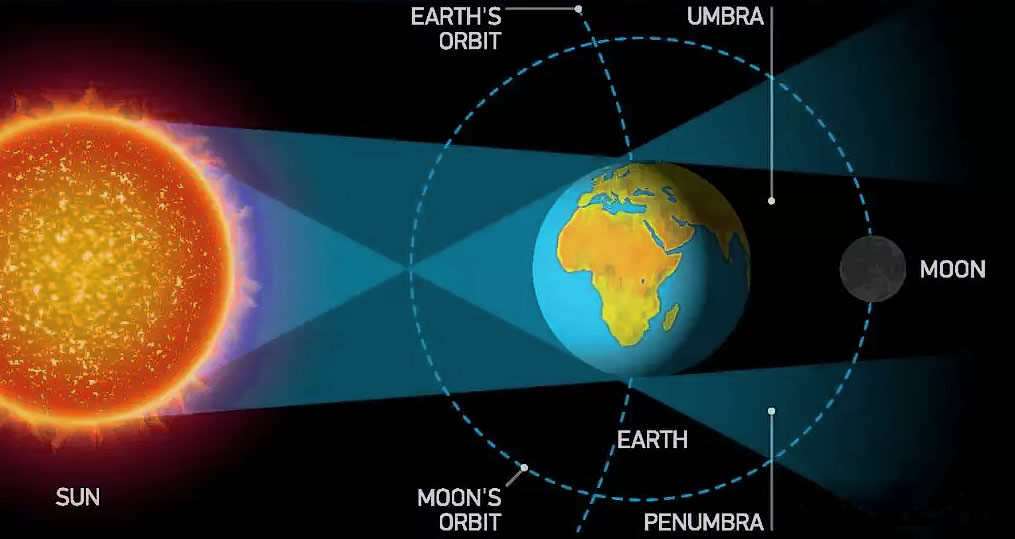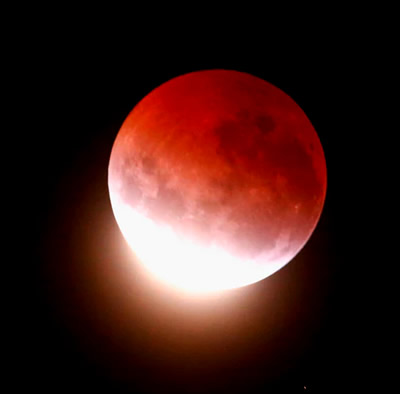|
||||||||
| How do eclipses occur? | ||||||||||||||||||
Lunar
eclipses 2024
|
||||||||||||||||||
Lunar
eclipses 2025
|
||||||||||||||||||
How
do eclipses occur?  Lunar Eclipse Geometry |
||
A lunar eclipse only happens around the time of a full moon, when the Sun, Earth and Moon are almost in a line (see diagram below). When the Moon enters the Earth's shadow, less light which reaches its surface has passed through the Earth's atmosphere and has been scattered by all of the dust and particles. The scattering removes most of the blue light leaving only redder colours, which is why the Moon appears orangey-brown. During a Partial lunar eclipse, only part of the Moon is inside this shadow, but with a Total lunar eclipse, the Moon is entirely inside the Earth's Umbra (the dark cone-shaped shadow in the picture). Because the Earth's shadow is much larger than the Moon, lunar eclipses can last nearly 4 hours, with a total lunar eclipse (Moon in the umbra) lasting up to 1 hour 40 mins. We
have several types of solar eclipses: Total, Partial, Annular and
Hybrid solar eclipses. These different types of eclipses occur
depending on which type of Moon's shadow reaches us on Earth.
When you are in the dark shadow region (called umbra) then you will
see a total eclipse where all sunlight will be cut off when the
whole of the Sun's disk is covered by the disk of the Moon.
This is of course one of the most amazing views in nature, because
day suddenly turns into night, at least for a short time.
This is the only time that one can view the Sun's outer atmosphere
called the corona and that itself is an amazing sight worth
experiencing. It is much cheaper and many more scientists
can use the opportunity of a Total Solar Eclipse to study the Sun
and its corona and its interaction with the Earth's atmosphere. |
The Blood Moon Blood Moon is not a scientific term but has come to be used due to the reddish color seen on a Super Moon during the lunar eclipse. When sunlight passes through the earth's atmosphere, it filters and refracts in such a way that the green to violet lights on the spectrum scatters more strongly than the red light. This results the moon to get more red light. Due to its reddish color, a totally eclipsed moon is sometimes referred to as a "blood moon". In addition, in the 2010s the media started to associate the term with the four full moons of a lunar tetrad, especially the 2014–15 tetrad coinciding with the feasts of Passover and Tabernacles. A lunar tetrad is a series of four consecutive total lunar eclipses, spaced six months apart. The blood moon prophecy is a series of apocalyptic beliefs promoted by Christian ministers John Hagee and Mark Biltz, which state that a tetrad (a series of four consecutive lunar eclipses—coinciding on Jewish holidays—with six full moons in between, and no intervening partial lunar eclipses) which began with the April 2014 lunar eclipse is a sign of the end times as described in the Bible in the Book of Joel, Acts 2:20 and Revelation 6:12. The tetrad ended with the lunar eclipse on September 27-28, 2015. |
 |
Do
Blood Moons Affect Your Zodiac Sign Differently Than Full Moons?
July is a cornucopia of astrological activity culminating in Mercury retrograde July 26 and a full blood moon and total lunar eclipse July 27. If you haven't heard of blood moons, and you're wondering if blood moons affect your zodiac sign differently than regular full moons, the answer is yes — because they always accompany a total lunar eclipse. Even though you won't be able to see the eclipse in North America, eclipses are powerful players in astrology, and they always stir up a lot of emotions. The July 2018 full blood moon isn't actually bloody, even though the fallout from the lunar eclipse might make it feel otherwise. The blood moon gets its name from the reddish hue it takes on when the Earth and sun align and block light to the moon. Historically, superstitious people attribute blood moons to misfortune, kind of like the chaos that ensues in the movie Practical Magic after a blood moon. While seen as unlucky, it's likely that calamity is associated with blood moons because the fear that something bad is going to happen causes people to make poor choices. What's more, the planets that influence the eclipse also play a role in how a blood moon and lunar eclipse affect you. "The lunar eclipse July 2018 astrology is mainly influenced by Mars, making this an emotionally challenging eclipse," Astrologer Jamie Partridge explained on Astrology King. "Mars' anger and frustration could easily turn to reckless actions because of a harsh aspect to Uranus. A more gentle influence from Saturn will make it a little easier to calm down, and some fixed stars give patience and decisiveness in a crisis. However, these same stars can also cause aggression and emotional problems." What's more, the July 2018 total lunar eclipse is the longest lunar eclipse this century, which only intensifies its cosmic energy. Basically, a lunar eclipse is like a full moon hopped up on more coffee than Lorelai Gilmore drinks in a year. It's strong AF, and spares no one. "A lunar eclipse focuses your attention on your emotions, intimate relationships, and your home and family," Partridge noted. "The longest total lunar eclipse this century is going to have an incredibly powerful influence on your private life." So, let's break it down. You'll be one day into the July 2018 Mercury retrograde cycle when the overly-caffeinated blood moon arrives on the scene to make you feel even more bajigitty. If you can stay home and pull the covers over your head July 26 to 27, that would be ideal.
A solar eclipse always precedes a lunar eclipse, and this month it happened July 12. This means the eclipse energy is already underway. If you've been feeling out of sorts, the July 2018 eclipse cycle is likely to blame. "In the weeks to come, expect the unexpected," Astrologer Ananda Shree explained on her website. "Eclipses are often tipping-points that shift situations, expedite change, and sometimes even pull the rug out from underfoot." Eclipses can be even more disorienting when you're not aware they're happening. During the 2017 eclipse cycle, there was so much hype about the total solar eclipse in August (because it was visible to almost everyone) that you were likely prepared to experience some eclipse side effects. When eclipses aren't visible in your hemisphere, you're not paying as much attention, which means it's easy to get blindsided by their unstable energy. During this particular lunar eclipse, your emotions will be in overdrive. Passion will be more powerful, anger can be explosive, sadness and frustration might feel overwhelming, and moments of happiness are likely to be euphoric. I'm not going to lie; it's going to be rough. However, the silver lining is that it's part of the growing pains necessary for caterpillars to emerge from their cocoons as beautiful butterflies. Even if you feel like you're stumbling around in the dark, in the words of the late Leonard Cohen, "There is a crack in everything. That's how the light gets in." Translation: Look for the light, follow it out of the tunnel, and let peace and relief wash over you like a cool eclipse moon bath. Feels good, right? |
| An
Eclipse Never Comes Alone! A solar eclipse always occurs about two weeks before or after a lunar eclipse. Usually, there are two eclipses in a row, but other times, there are three during the same eclipse season. |
|
| Copyright
© 2004 ABC-people.com Design and conception BeStudio © 2014-2024 |